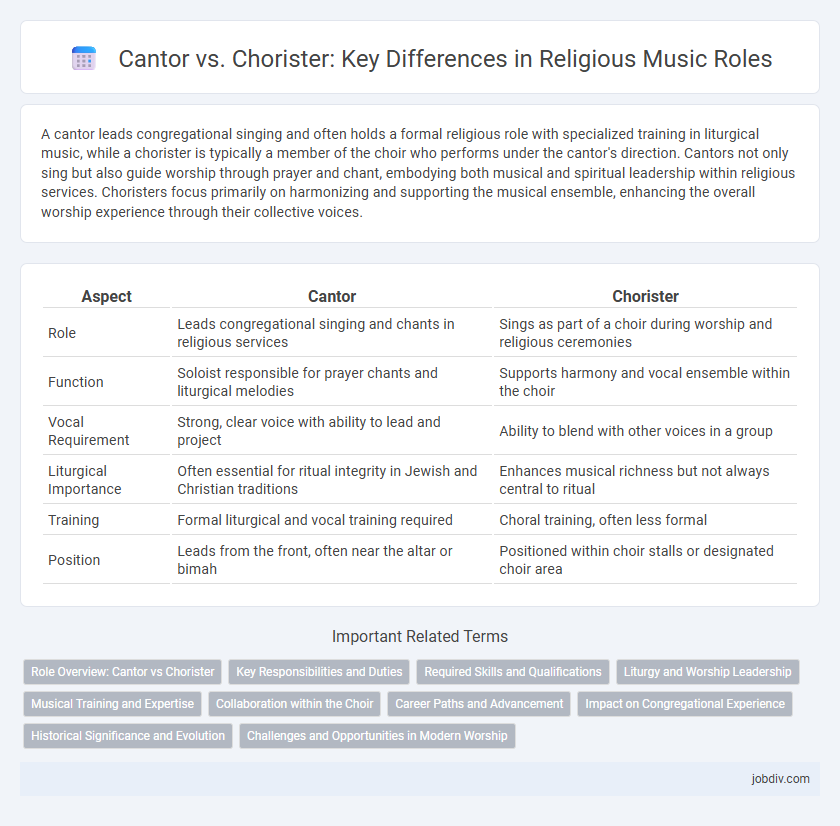A cantor leads congregational singing and often holds a formal religious role with specialized training in liturgical music, while a chorister is typically a member of the choir who performs under the cantor's direction. Cantors not only sing but also guide worship through prayer and chant, embodying both musical and spiritual leadership within religious services. Choristers focus primarily on harmonizing and supporting the musical ensemble, enhancing the overall worship experience through their collective voices.
Table of Comparison
| Aspect | Cantor | Chorister |
|---|---|---|
| Role | Leads congregational singing and chants in religious services | Sings as part of a choir during worship and religious ceremonies |
| Function | Soloist responsible for prayer chants and liturgical melodies | Supports harmony and vocal ensemble within the choir |
| Vocal Requirement | Strong, clear voice with ability to lead and project | Ability to blend with other voices in a group |
| Liturgical Importance | Often essential for ritual integrity in Jewish and Christian traditions | Enhances musical richness but not always central to ritual |
| Training | Formal liturgical and vocal training required | Choral training, often less formal |
| Position | Leads from the front, often near the altar or bimah | Positioned within choir stalls or designated choir area |
Role Overview: Cantor vs Chorister
A cantor leads the congregation in liturgical chants, often serving as the primary vocal soloist during worship services, while a chorister participates as a member of the choir, supporting harmonies and group singing. The cantor's role emphasizes vocal leadership and solo performance skills, whereas choristers contribute to collective vocal arrangements and musical accompaniment. Both are essential in enhancing the spiritual atmosphere but differ in their responsibilities and vocal prominence.
Key Responsibilities and Duties
A cantor leads the congregation in prayer and chant, specializing in liturgical music and vocal leadership during religious services. Choristers support the worship experience by singing harmonies and enhancing the musical quality of the choir, often following the cantor's direction. Both roles require a deep understanding of sacred music, but the cantor holds primary responsibility for guiding the musical worship.
Required Skills and Qualifications
Cantors require extensive vocal training, strong pitch control, and knowledge of liturgical music to lead congregational singing effectively. Choristers must possess good vocal ability, the capacity to harmonize, and often need experience in reading musical notation to support the choir. Both roles benefit from a deep understanding of religious texts and the ability to convey spiritual emotion through music.
Liturgy and Worship Leadership
Cantors lead liturgical singing and chant, serving as primary worship leaders who guide the congregation in prayer through music within religious services. Choristers support the worship by providing harmonic and melodic accompaniment, often enhancing the congregation's participation without directly leading. Both roles are essential in creating a spiritually uplifting worship experience, with cantors emphasizing vocal leadership and choristers contributing to the overall musical texture in liturgy.
Musical Training and Expertise
Cantors undergo extensive formal musical training, often including vocal techniques, liturgical chant, and music theory specific to religious services, while choristers typically receive foundational vocal training focused on harmonizing and blending within a choir. Cantors possess specialized expertise in leading congregational singing and interpreting sacred music, whereas choristers support the musical ensemble by executing complex choral arrangements under the cantor's direction. The depth of musical knowledge and solo performance skills generally distinguishes cantors from choristers in religious worship settings.
Collaboration within the Choir
Cantors and choristers collaborate by blending solo vocal leadership with harmonious group singing, enriching the liturgical experience. The cantor leads melodic prayers and chants, while choristers provide harmonic support and communal resonance, creating a dynamic worship atmosphere. Effective coordination ensures seamless transitions between solo and ensemble passages, enhancing the spiritual impact of the service.
Career Paths and Advancement
Cantors often pursue formal theological education and training in liturgical music, positioning themselves for leadership roles within religious institutions and opportunities to lead worship services or teach sacred music. Choristers typically begin as choir members, gaining experience through participation in church choirs or community ensembles, which can lead to roles as choir directors or music educators. Advancement for cantors involves deeper engagement with religious authority and ritual specialization, while choristers may expand their careers into broader musical or educational fields.
Impact on Congregational Experience
A cantor leads the congregation in worship through skilled vocal leadership and liturgical expertise, fostering deeper spiritual engagement and participation. Choristers support the musical foundation by enhancing harmonies and providing rich, layered choral textures that elevate the overall worship atmosphere. Together, their distinct roles significantly impact the congregational experience by promoting unity, devotion, and emotional connection during religious services.
Historical Significance and Evolution
Cantors have historically held a prominent role in Jewish and Christian liturgies, leading congregational prayers and chanting sacred texts with authoritative vocal techniques dating back to ancient times. Choristers emerged during the medieval period, evolving as trained singers in church choirs who perform harmonized hymns and polyphonic compositions integral to liturgical music development. The evolution from solo cantorial chants to organized choral arrangements reflects broader shifts in religious worship practices and the increasing complexity of sacred music traditions.
Challenges and Opportunities in Modern Worship
Cantors in modern worship face the challenge of maintaining traditional liturgical roles while embracing contemporary musical styles that engage diverse congregations. Choristers encounter opportunities to collaborate with technology-enhanced sound systems, expanding vocal arrangements and participation beyond the physical church space. Both roles must adapt to shifting demographics and digital worship platforms, balancing historical reverence with innovative expression to enrich spiritual experiences.
cantor vs chorister Infographic

 jobdiv.com
jobdiv.com